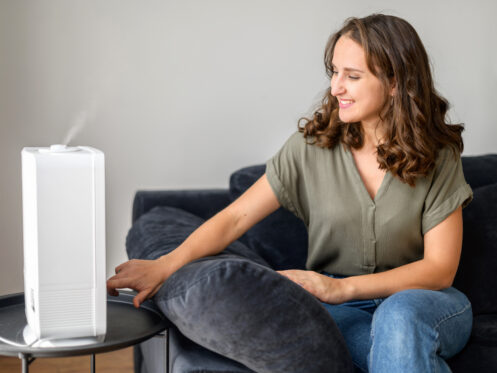When summertime weather in Bountiful, UT, comes around, you’re likely dreading the effects that it will have on your allergies. While you may think that being outdoors is bad for your allergy flare-ups, that’s not always the case. The air inside your home can trap harmful allergens, which can make it difficult to control your allergy symptoms. Some studies conducted by the EPA have suggested that residential indoor air quality can be between two and five times worse than outdoor air quality.
Why Are Allergy Symptoms Worse Indoors?
Allergy symptoms, such as sneezing and itchy eyes, are the result of your body encountering contaminants known as allergens. While you may instantly think of pollen and other outside allergens as the main cause of your symptoms, there’s likely more that’s impacting you. Indoors, your allergies can easily be triggered by dust mites, pet dander, and mold spores. You and your family members can also track outdoor allergens, like pollen, into your home.
As your air conditioning system runs, these allergens are constantly circulated throughout the various rooms of your home. This can lead to you inhaling allergens while you’re at home and experiencing allergy flare-ups frequently. The best way to combat allergy symptoms at home is to enhance the quality of your indoor air.
The Importance of Air Quality Testing
One of the best things you can do to start enhancing the quality of air inside your home is to invest in a professional air quality assessment. With this test, one of our HVAC technicians will test your air quality in various areas of your home. These quality tests will check for levels of contaminants like mold, VOCs, and even gases like carbon monoxide.
Indoor air quality testing will allow you to detect the most common contaminants in your home, so you can work to reduce them. It also serves as a baseline for you to come back and have your air tested again. This way, once you implement a particular method to enhance your air quality, you can see if there’s a difference and how much of one.
It’s also important to note that getting an air quality assessment by a professional will include a visual inspection of your home. They will be able to provide insight into potential hazards that are reducing the quality of your indoor air. For example, they may find mold in your bathroom that is contributing to a high level of mold spores in the air. When these problems are identified, you can work to fix them to prevent exposure.
HVAC Air Filter Benefits
If you keep up with regular filter changes for your HVAC system, you may be wondering why allergens are still present in your home. Your cooling system’s air filter can trap some of these airborne particles. However, most HVAC filters are designed in such a way that they only trap a certain amount of particulate matter.
You can invest in an air filter with a higher MERV rating. MERV stands for Minimum Efficiency Reporting Value. This measures the overall effectiveness of your air filter. The higher the MERV rating, the more effective the filter will be at removing unwanted airborne particles.
MERV ratings range from single digits all the way up to 20. While you may want to immediately invest in a MERV filter with a high rating to remove airborne allergens, this is not a good idea. Most HVAC systems can handle a filter with an average MERV rating of around 12.
If you start to get into a higher MERV range, it will significantly reduce the overall efficiency of your cooling system. Your HVAC unit must be able to pull air through the filter. If the filter is so tightly compact that it will catch even the finest of particles, your cooling system is going to struggle tremendously to pull air through it.
Typically, filters with a MERV rating of 13 to 20 are reserved for sterile buildings, like hospitals and operating rooms. This allows for the removal of things like bacteria and pathogens. A filter with a MERV rating between 8 and 12 is ideal for the average household. A filter in this range will remove airborne particles like dust mites, pollen, mold spores, and dust.
If your current filter has a MERV rating below eight, then consider an upgrade. If you’re comfortable investing more money in a higher-rated filter, then consider the higher-end 12 MERV filters.
Investing in a Whole-Home Air Scrubber
You may be familiar with simple portable filtration devices that help filter air in a specific room of your home. However, there are whole-home air scrubber systems that can be added to your existing HVAC ductwork to provide better air quality for your entire home. These systems work to remove allergens with the added benefit of removing bacteria, viruses, and even bad odors.
A whole-house air scrubber often includes ultraviolet (UV) light and titanium oxide-coated rods. These two components work in unison to change the molecular structure of harmful allergens so that they are harmless to your body. Furthermore, air scrubbers with specialized ion-charging technology will create negatively charged ions. These ions will circulate through the rooms of your home and adhere to any allergens in the air or on your surfaces, like dust mites. This makes allergens more likely to be pulled into your ductwork for further filtering.
Consider a Whole-Home Air Purifier
While an air scrubber may seem like a great option, it does come with a high price tag. If you’re looking for a more affordable option that still works to drastically enhance the quality of air inside your home, you may want to consider a whole-home air purifier.
This system gets positioned right inside your ducting, like that of an air scrubber. However, air filtration and purification devices get placed in the return ducting to catch airborne particles before they enter your indoor air handler components. Depending on your preferences, you can choose between different purification filters and add-ons.
Most air purifiers will come standard with a HEPA filter. This stands for high-efficiency particulate air filter, which traps around 99.97% of all airborne particles down to 3 microns in size. In some cases, you may want to opt for an extended media filter. Unlike a flat-style filter, the extended media filter looks more like an accordion that has much more surface area to trap unwanted airborne particles. Think of this as a multi-stage filtering process.
If you would like to add filtering for lingering odors to your air purification system, then you’ll need to invest in an activated carbon filter. These are typically combined with a traditional HEPA filter to offer dual functionality.
Reliable Indoor Air Quality Service
Blue Best Plumbing, Heating, Air, Generators offers reliable indoor air quality services to the entire Bountiful community. We can also assist with all your heating, cooling, heat pump, ductless mini-split, plumbing, ductwork, and commercial needs. Simply call us today to schedule a service appointment with one of our highly knowledgeable HVAC technicians.








